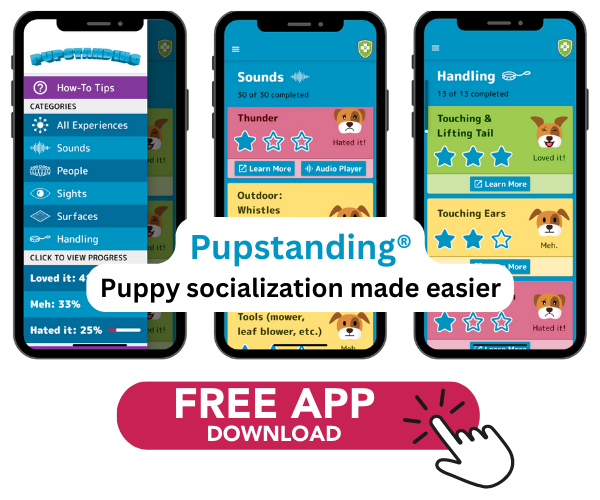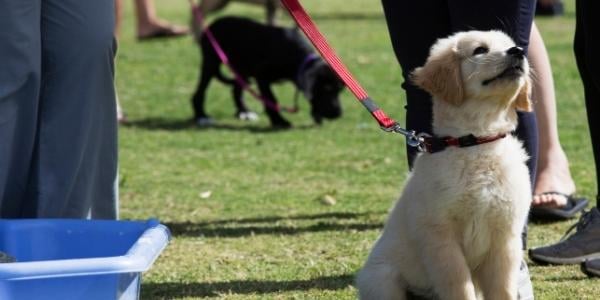 Early socialization and training are essential for setting your new puppy up for success. It can be overwhelming for new dog owners to choose the right class with all of the options out there.
Early socialization and training are essential for setting your new puppy up for success. It can be overwhelming for new dog owners to choose the right class with all of the options out there.
Merely taking your pup to the dog park isn’t enough to properly socialize them — an uncontrolled environment can often lead to bad experiences and can expose your puppy to harmful illnesses!
It’s essential to manage their experiences during the critical socialization window known as the imprint period. You want to make sure that your puppy learns how to interact appropriately with dogs and people, and group classes provide a great environment to do this. Classes are also a perfect place to practice necessary training skills around distractions.
Why Attending a Puppy Class Is Important
Even if you’ve had and trained dogs before, you and your new dog (especially a puppy) will benefit from a group class environment for a variety of reasons:- A dog trainer can give you real-time feedback on your training techniques that an online video or article simply can't.
- Personal attention from a trainer saves you from making unnecessary mistakes. Plus, having their expertise readily available makes it easier to troubleshoot behavior issues as they relate specifically to your lifestyle and home environment.
- Your trainer will get to know you and your puppy's characteristics and temperament and can help you approach their training most effectively.
- A group class provides opportunities to practice around distractions that aren't available in your home. Practicing around distractions takes your dog's skills to the next level if they've already perfected them in your living room.
Most importantly, attending a group dog training class helps to build the bond between you and your puppy. You'll be learning new skills together, and starting the training journey in a new and fun environment.
Socialization Versus Puppy Obedience Classes
There are various types of puppy training classes — some focus on basic training cues using a set curriculum. Others are drop-in socialization groups that only provide off-leash play and others that are a combination of the two. So which do you choose? You'll want a class that provides opportunities for your puppy to learn bite inhibition and proper dog-dog communication. You'll also want to introduce training skills that encourage impulse control and build a strong foundation for the relationship between you and your puppy.
Classes that focus only on obedience training are a great start. However, puppy play and socialization classes are important too, especially when your puppy is still young and learning how to interact with other dogs. Ideally, your puppy class will be a combination of training and play.
Off-leash playtime should be interspersed between basic training instruction, focusing on important foundational cues like coming when called and leash manners. There is nothing wrong with a puppy obedience class that doesn't include playtime; simply make sure that you're providing play and socialization opportunities outside of class.
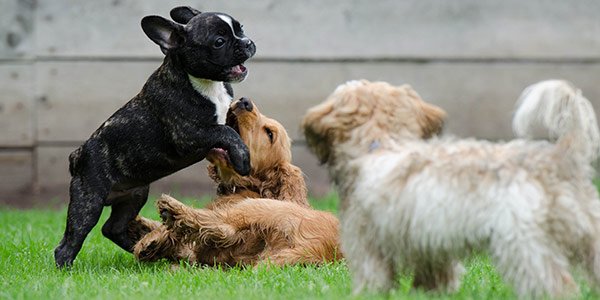
How to Pick the Right Puppy Class
Before you sign up for your first puppy class, check out these tips to ensure you’re setting yourself and your puppy up for a fun, safe, and successful experience:
Ask Around and Get a Preview
Ask your veterinarian for their recommendations
Your vet clinic will likely know of local trainers and might even work closely with a particular program. They’ll also have the benefit of hearing from other clients about their experiences with different classes. Your vet will also make sure that your puppy is properly vaccinated before being exposed to public places and other dogs. This is typically about a week or so after their first vaccine and deworming visit with your veterinarian.
Ask friends, neighbors, and read online reviews
If you know someone who recently went through the puppyhood phase with their dog, pick their brain about their experience in puppy class. Online reviews are another useful tool in getting an idea of how different classes work and if they’re the right place for you.
Ask to watch a class first
Once you’ve narrowed down your choices, ask to preview a class before signing up. Many dog trainers allow prospective clients to watch from the sidelines to get a feel for whether the course is right for them. This will enable you to see how classes are run and if the "vibe" is right. You can ask questions about how they keep their facility clean and observe the teaching style and techniques to make sure you're comfortable with the trainer and their methodology. Consider whether the class aligns with your expectations and training goals with your dog.
Puppy Classroom Requirements
Is it clean?
Responsible training programs require up-to-date vaccinations and that your puppy is given a clean bill of health before they are allowed to enroll. Their immune systems are still developing and are more susceptible to infections than adult dogs. Avoid classes that don't ask for proof of vaccinations!
The classroom should be regularly and properly cleaned using products that are safe for animals and effective in preventing the spread of bacteria and viruses. Puppies tend to have lots of potty accidents — especially in an exciting and stimulating environment like a puppy playgroup. Take note of how these potty mishaps are handled to make sure that your puppy won’t be exposed to nasty germs.
Don't feel bad asking how often the classroom area is sanitized and what products are being used. A top-shelf training program will be confident in telling their clients what their protocol is for ensuring the health of the puppies in their class. The training space should look and smell clean without the overwhelming smell of chemicals. Most dog training facilities will deep clean their area weekly using veterinarian-hospital grade disinfectants such as Virkon, Wysiwash, or Neogen. They'll also perform regular spot cleaning in between with all-natural and pet-safe cleaning products. Their cleaning routine and products should kill viruses (Parvo, Distemper, and Influenza), bacteria (Kennel Cough), and protozoa (Giardia).
Is it calm and controlled?
Puppy play can get loud and rambunctious, but is there an underlying sense of the trainer being in control of the environment? Or is the trainer running around after herds of puppies doing their best impression of a headless chicken?
A good puppy class should limit the number of dogs in the class to ensure safety during the off-leash time and provide personal attention to each puppy owner. A ratio of one trainer to six puppies tends to be an ideal number for most dog trainers. Consider the size of the classroom. Too much open space can make it hard to monitor puppy play; not enough space and puppies may feel crowded and overwhelmed.
Some puppies are more cautious in a group environment and need extra time and space to acclimate to all that activity! Having a "quiet corner" for shy and cautious puppies is a wonderful indication that your dog trainer has your puppy's best interests in mind.
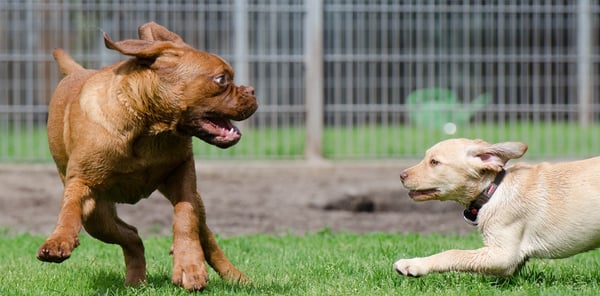
No Bullies Allowed!
Your dog trainer should ensure that puppies exhibiting any pestering or bullying behavior in play are being managed and taught to inhibit their bites, learn better impulse control, and work to build confidence in the more cautious puppies. Dogs with similar play styles should be matched together and carefully watched to prevent escalation of play into fighting or inappropriate chasing.
Humans can't teach dogs how to speak dog. However, we can make sure they are listening to each other to encourage positive interactions and prevent over-correction during play. Puppy class is an ideal environment to watch and learn about canine body language and how dogs "talk" to each other.
Size Shouldn't Matter
Some classes separate puppies by size. Still, it's important to expose your dog to varying sizes of dogs while they are young to build positive associations with all breeds, from teacup to giant-sized. It's also imperative that larger breeds of puppies learn how to self-handicap while playing with smaller breeds, and that won't happen if they are never allowed to interact with each other.
There is nothing wrong with a playgroup or class that separates by size; some class facilities simply don't have space, or they're making sure all puppy owners are comfortable and don't feel overwhelmed with larger breeds. Just make sure your puppy is exposed to dogs of all sizes to prevent any fearful reactions in their future. If your class allows puppies of all sizes to play together, interactions should be appropriately supervised and managed so that every dog has a positive experience.
Enrichment and Desensitization
Does the class provide enrichment and desensitization opportunities for your puppy to build positive associations with items such as vacuums, umbrellas, etc.? Are there different surface textures or obstacles for your puppy to explore and puzzle toys to provide mental enrichment?
Here's an example from one of my group puppy/teenager classes. We're introducing different items, like a wheelchair and balance discs in a positive way, and focusing on rewarding attention to the owner while off-leash. The humans are all wandering around calmly and whenever their puppy is by their side, they click and treat. (I'm the one in the blue sweatshirt, and you'll notice I have two pups following me around — trainers are often the biggest distraction in puppy class. Dogs learn quickly who pays the best for good behavior!)
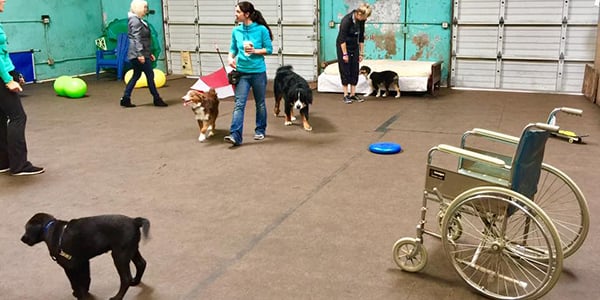
A good puppy class will talk about how to calmly introduce your pup to potentially scary things and experiences that they are likely to encounter outside of the classroom and provide a slow introduction to such items. If a puppy already has a positive association with the classroom, it's a wonderful place to desensitize them to nail trimmers and other grooming tools, as well as expose them to new people wearing novel items like sunglasses or hats. For video resources to help you socialize your puppy the right way, check out this Puppy Socialization Video List.
Some trainers allow the entire family to attend a puppy class, which gives you the chance to teach your puppy that children are not scary, and how to greet them safely and politely. If the course you attend does allow more than one handler per dog, take advantage of this! The more family members involved in training, the more consistent training expectations and cues will be for your dog, which results in faster learning.
Positive and Humane Training Techniques
Puppy classes should never use aversive tools or corrections to teach your puppy manners or manage their off-leash play. Run the other way if a trainer relies on squirt bottles, shaker cans, yelling, or physical corrections to control the environment or teach basic training cues. These techniques are not only ineffective and damage your relationship with your puppy, but also create negative associations that can take a lifetime to fix!
Instead, choose a puppy class that focuses on using positive reinforcement of desired behaviors. Lessons should be fun for both you and your pup — it's all about building a strong bond between the two of you. The more you reward a behavior, the more your puppy will choose to do it.
For example, class time is a perfect opportunity for your puppy to learn that jumping on people never gets them attention. A well-run class will encourage everyone to be consistent in ignoring a puppy who jumps up for attention and rewarding them for sitting nicely. This will help your pup generalize polite greetings to every human they encounter, not just you and your family. It truly takes a village!
There are many different terms regarding training philosophies and techniques, and it can be confusing to understand what they mean. When looking for a puppy class that uses positive and humane training techniques, keep an eye out for terms such as Force-Free, Clicker Training, Reward-Based, Science-Based, and Fear-Free Training. These all refer to the use of positive reinforcement (rewarding your dog for a behavior you like) and most likely will steer clear of the use of positive punishment (using an aversive on your dog when they do something you don't like).
Watch out for terms like "Balanced," Blended, Dominance-Based, or Alpha Dog Training. These methodologies will include physical corrections and other aversives on your puppy, which you want to avoid to keep the human-canine bond healthy.
MYTH BUSTING: Positive training does not mean permissive. A good positive reinforcement trainer will also utilize what's called "negative punishment" when needed, meaning that a puppy loses out on something they want when they perform an unwanted behavior such as jumping, barking, or nipping. This could be they lose the opportunity for a treat, attention, playtime privileges, etc.
But an even better positive reinforcement trainer will set up the training environment for success so that a puppy is more likely to make good choices and not exhibit unwanted behaviors in the first place.
Trainer Certification
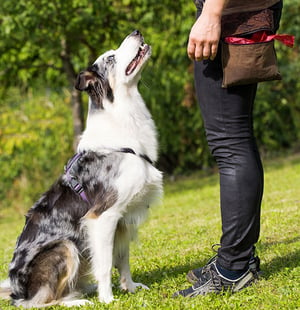 Take into account what education and certification your dog trainer has when choosing what class to attend. Sadly, the dog training industry is unregulated — anyone can call themselves a dog trainer or behaviorist. An uninformed instructor (or one who uses outdated techniques) can have disastrous effects on your dog’s behavior that you'll have to fix later.
Take into account what education and certification your dog trainer has when choosing what class to attend. Sadly, the dog training industry is unregulated — anyone can call themselves a dog trainer or behaviorist. An uninformed instructor (or one who uses outdated techniques) can have disastrous effects on your dog’s behavior that you'll have to fix later.
Did your trainer complete a certification through a reputable dog training and behavior program? If so, they have invested lots of time, money, sweat, and tears in learning how to train dogs and understand their behavior, which speaks to their commitment and motivation. Read "What You Should Ask a Dog Trainer and What Their Answers Should Be" for a list of questions to ask a potential trainer for your dog.
While it may look like a letter salad, these programs require many hours working with clients, passing exams, case studies, peer reviews, references, and a commitment to humane training techniques. Check out the list below for some of the most well-known certifications that mean your trainer has met these extensive requirements and is committed to being in good standing within the dog training industry:
- Certification Council for Professional Dog Trainers (CPDT-KA, CPDT-KSA)
- Karen Pryor Academy (KPA-CTP)
- International Association of Animal Behavior Consultants (ACDBC, CDBC)
- Association of Animal Behavior Professionals (AABP-CDT)
- Certified Behavior Adjustment Training Instructor (CBATI)
- Victoria Stilwell Academy for Dog Training and Behavior (VSA-CDT)
- Fear Free Certified Professional
- Northwest School of Canine Studies (CCS)
Puppy Class is for the Humans Too!
Going to puppy class isn't just for the dogs — it's a great place to get feedback on your dog's temperament, learn about canine body language, and how best to communicate with them. Plus, it will set them up for success as they navigate puppyhood. Effective dog training also relies on good training mechanics on the human side of the equation. You'll learn how and where to place treat rewards, use toys as reinforcement, and how to move your body to make learning easier for your dog. These things are especially important for skills like heeling, loose leash walking, or if you ever want to get into fun dog sports like agility.
When choosing a puppy class, pick a trainer whom you feel matches your learning style and understands how to communicate best with you and your family.
The more you understand dog behavior and training, the faster your puppy will learn, and the easier your life will be! There's nothing quite like the joy of connecting with your puppy and growing with them as they learn about the world. A quality puppy class will not only support you in that journey but ensure you enjoy yourself along the way.




